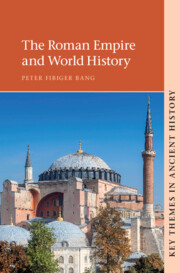Refine search
Actions for selected content:
149391 results in Classical Studies
Chapter Six - Conclusion
-
- Book:
- The Archaeology of the Cyclades in the Roman and Late Antique Periods
- Published online:
- 23 October 2025
- Print publication:
- 06 November 2025, pp 140-156
-
- Chapter
- Export citation
References
-
- Book:
- The Archaeology of the Cyclades in the Roman and Late Antique Periods
- Published online:
- 23 October 2025
- Print publication:
- 06 November 2025, pp 235-256
-
- Chapter
- Export citation
Introduction
-
- Book:
- Playing the Chorus in Greek Tragedy
- Published online:
- 23 October 2025
- Print publication:
- 06 November 2025, pp 1-25
-
- Chapter
- Export citation
Copyright page
-
- Book:
- Playing the Chorus in Greek Tragedy
- Published online:
- 23 October 2025
- Print publication:
- 06 November 2025, pp iv-iv
-
- Chapter
- Export citation
Chapter 1 - Poetry in Herodotus, Herodotus on Poetry
-
- Book:
- Herodotus and the Greek Poetic Tradition
- Published online:
- 04 November 2025
- Print publication:
- 06 November 2025, pp 11-35
-
- Chapter
- Export citation
Notes on Style, Abbreviations and Texts
-
- Book:
- Playing the Chorus in Greek Tragedy
- Published online:
- 23 October 2025
- Print publication:
- 06 November 2025, pp xi-xii
-
- Chapter
- Export citation
Index Locorum
-
- Book:
- Herodotus and the Greek Poetic Tradition
- Published online:
- 04 November 2025
- Print publication:
- 06 November 2025, pp 738-741
-
- Chapter
- Export citation
5 - Theological Themes
- from Part II - The World of the Text
-
- Book:
- The Gospel of Truth
- Published online:
- 23 October 2025
- Print publication:
- 06 November 2025, pp 106-138
-
- Chapter
- Export citation
2 - Translation
- from Part I - Introduction and Translation
-
- Book:
- The Secret Book of John
- Published online:
- 23 October 2025
- Print publication:
- 06 November 2025, pp 28-54
-
- Chapter
- Export citation
Part III - Herodotus and Greek Tragic Poetry
-
- Book:
- Herodotus and the Greek Poetic Tradition
- Published online:
- 04 November 2025
- Print publication:
- 06 November 2025, pp 549-565
-
- Chapter
- Export citation
Agathias’ Greek: sixth-century language through two case studies from the Histories
-
- Journal:
- Byzantine and Modern Greek Studies , First View
- Published online by Cambridge University Press:
- 05 November 2025, pp. 1-18
-
- Article
- Export citation
TIMOTHY A. JOSEPH, Thunder and Lament: Lucan on the Beginnings and Ends of Epic. New York: Oxford University Press, 2022. Pp. 312. isbn 9780197582145. £64.00.
-
- Journal:
- The Journal of Roman Studies , First View
- Published online by Cambridge University Press:
- 05 November 2025, pp. 1-2
-
- Article
- Export citation

Herodotus and the Greek Poetic Tradition
-
- Published online:
- 04 November 2025
- Print publication:
- 06 November 2025
JESSICA BLUM-SORENSEN, Epic Ambition: Hercules and the Politics of Emulation in Valerius Flaccus’ Argonautica (Wisconsin studies in classics). Madison: University of Wisconsin Press, 2023. Pp. 327. isbn 9780299344603. $99.95.
-
- Journal:
- The Journal of Roman Studies , First View
- Published online by Cambridge University Press:
- 04 November 2025, pp. 1-2
-
- Article
- Export citation
LEE L. BRICE and ELIZABETH M. GREENE (Eds), Women and the Army in the Roman Empire. Cambridge and New York: Cambridge University Press, 2025. Pp. xxiv + 332, illus., maps. isbn 9781107068575. £105.00.
-
- Journal:
- The Journal of Roman Studies , First View
- Published online by Cambridge University Press:
- 03 November 2025, pp. 1-3
-
- Article
- Export citation
PAUL HAY, Saeculum: Defining Historical Eras in Ancient Roman Thought. Austin: University of Texas Press, 2023. Pp. viii + 262. isbn 9781477327395 (hbk), £49.00; 9781477327401 ebook; 9781477327418 ebook.
-
- Journal:
- The Journal of Roman Studies , First View
- Published online by Cambridge University Press:
- 03 November 2025, pp. 1-2
-
- Article
- Export citation
The ‘alternative preface’ to Theophilos Korydalleus’ Logic: a minor episode of factional intrigue in the Patriarchal School of Constantinople in the seventeenth century
-
- Journal:
- Byzantine and Modern Greek Studies , First View
- Published online by Cambridge University Press:
- 03 November 2025, pp. 1-20
-
- Article
-
- You have access
- Open access
- HTML
- Export citation
COLONIAL FAMILIES AT ROMAN KNOSSOS: THE CASE OF CAELIA Q.L. CHIA
-
- Journal:
- Annual of the British School at Athens , First View
- Published online by Cambridge University Press:
- 03 November 2025, pp. 1-17
-
- Article
- Export citation

The Roman Empire and World History
-
- Published online:
- 31 October 2025
- Print publication:
- 30 October 2025
Dedication
-
- Book:
- The Roman Empire and World History
- Published online:
- 31 October 2025
- Print publication:
- 30 October 2025, pp v-vi
-
- Chapter
- Export citation
